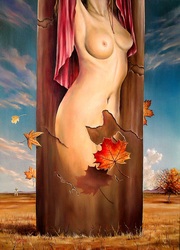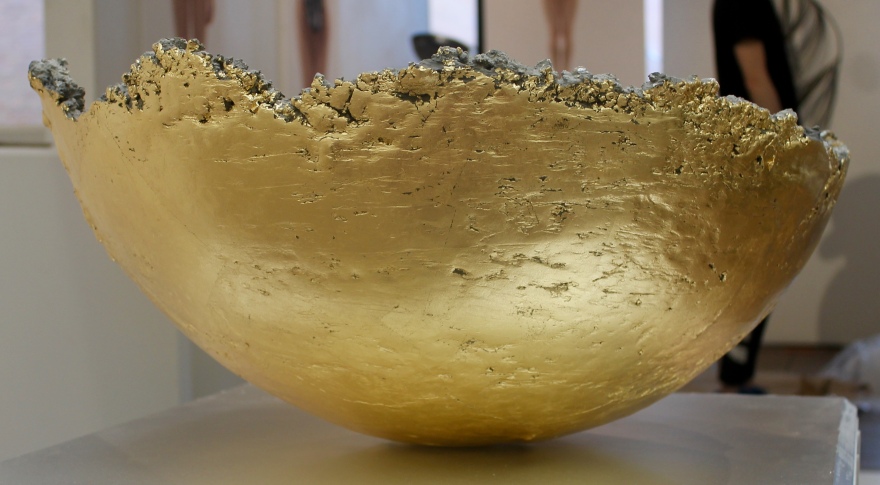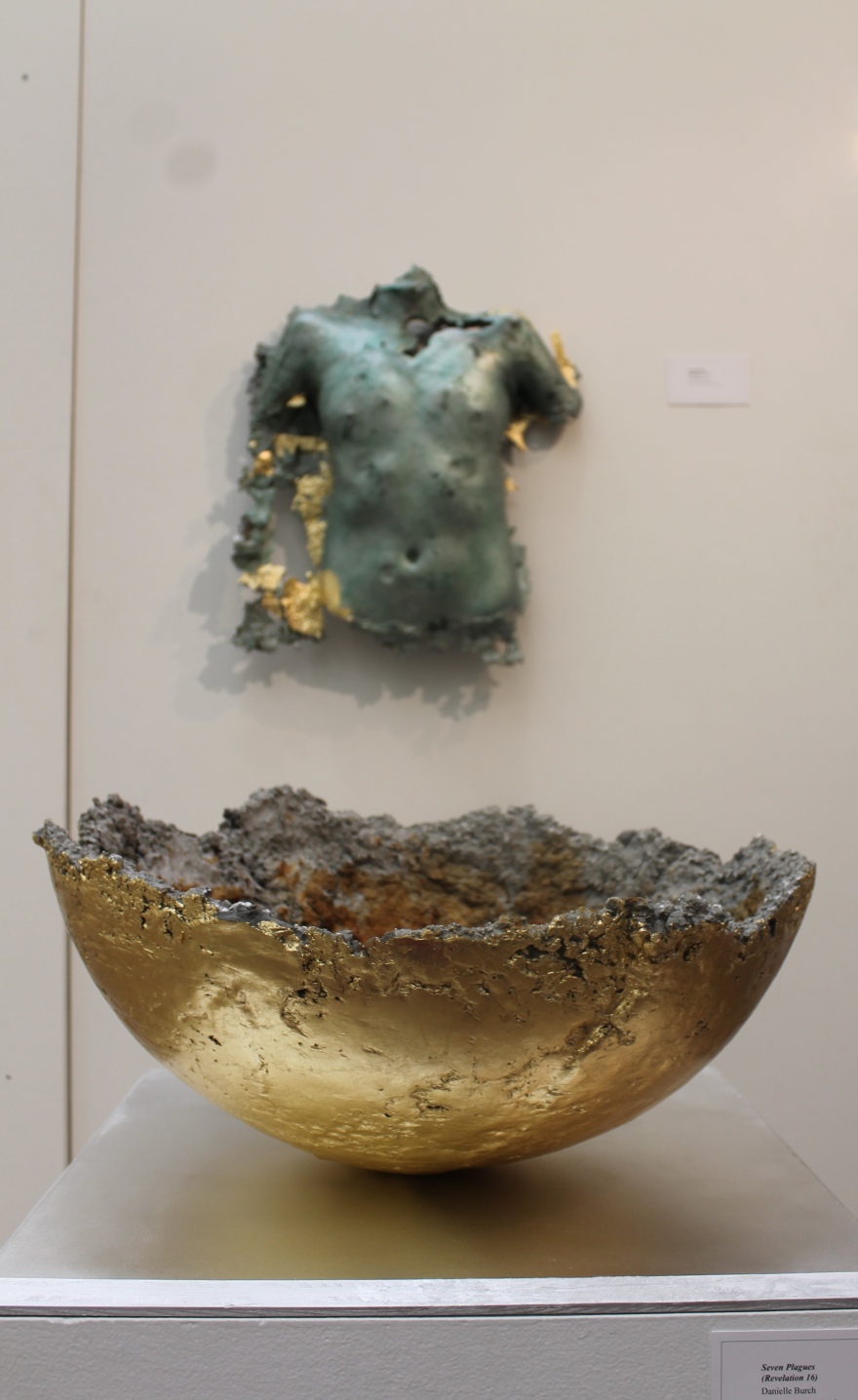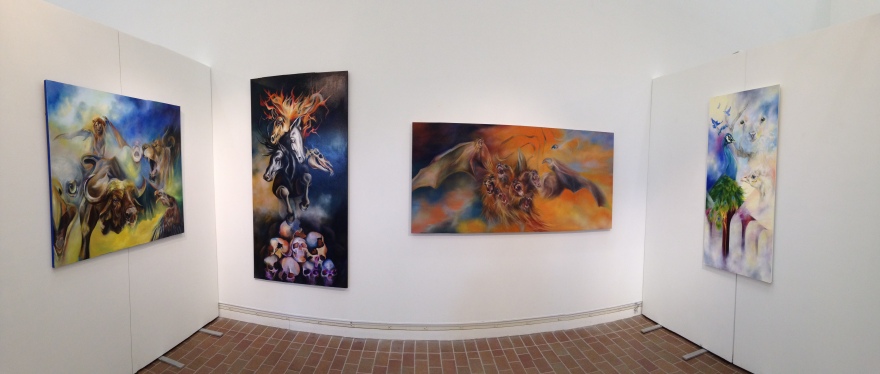This is a paper I wrote for a class in my MFA program while I was at RIT. It included a presentation and the following document. Needless to say, I LOVE writing, especially when I am able to pick a topic so near and dear to my heart as art, specifically Surrealism!
Enjoy and, as always, feel free to comment and/or contact me!
The Femme-enfant as Employed (Objectified) by Surrealist vs Western Contemporary Art’s Objectification of Women
(with an analysis of Breton’s Nadja)
In much of Western Contemporary art history—the practice, the critique, and the institutional existence— the dominating force has been that of white, heterosexual males. Due to this prevalence, a certain “standard” of creating artwork involving the female nude has emerged as “natural,” though its precise role in art has changed throughout history. In many Western Contemporary pieces of art, from the paint ejaculations of Jackson Pollack to the violently dominating strokes of Willem De Kooning, the female nude has been employed as an objectified means of transcendence. The artist uses the abstraction of the female nude to seek liberation from the confines of Realism and morality and to escape the feminine threat of castration, inherent in the female nude.
According to Phyllis Evans in The Mirror and the Muse: Female Artists and Surrealism, there is at least one group of artists who reject this dominant use of the female nude in Western art: Surrealists. The Surrealist use of the female nude is referred to as the Femme-enfant; based on the the French words for “female” and “infant.” As such, the potential complications of the term itself become evident. Although Surrealists, unlike many of their Western Contemporary counterparts, outwardly advocate the liberation and creativity of women, they arrest the development of their muse. In theory, by rejecting the rational thought portrayed in the transcendence-seeking nature of Western Contemporary art, they idolize the characteristics and connotations of femininity. However, in practice, they are just as objectively patronizing as their Western Contemporary counterparts, if not more so. In their work, the portrayal of these women is immature, incomplete and dependent, but beautiful. Often, the Femme-enfant is inhibited or restricted, as they are in much Western art. It could be argued that the Surrealist Femme-enfant is more restraining than Western Contemporary Art’s objectification of women, because the female’s body is frequently portrayed as visually and physically incomplete, literally immobilizing her and/or restricting her movement.
To fully understand the Femme-enfant, one must first analyze Andre Breton’s surrealist writing, Nadja. Breton writes about his unequivocal love for a woman named Nadja. Nadja was mentally disabled and unable to “distinguish between illusion and reality, obsessive behavior, and dark eccentricity” and so she represented, to Breton, the completely irrational complement to the rational side of masculinity. (It is important to note that Breton also wrote The First Surrealist Manifesto of 1924) At first, Breton falls in love with Nadja for her irrationality and natural intuition, both of which are embodiments of the Femme-enfant. Recounting his words to Nadja, Breton says “you, the most vital of beings, who seem to have been put in my path only so I may feel in all its rigor the strength of what is not felt in you. You who know evil only by hearsay. You, indeed, ideally beautiful.” This is where the Femme-enfant’s innocence and lack of rational, cerebral (masculine) knowledge begins.
However, over time, sweet, helpless Nadja is unable to overcome her “growing madness” caused by the lack of restricting rationality in her nature. This madness renders her portrayal not so different than femininity’s portrayal in De Kooning’s Woman series. Eventually, Nadja is institutionalized for her so-called insanity and the Femme-enfant is known as an irrational muse, who needs the rationality that men provide in order to survive in an agreeable state. According to Breton, men are able to withstand the irrationality of the subconscious because they inhabit the rational realm of logic, whereas the Femme-enfant only exists in the liminal space between reality and the subconscious, yet natural, dreamscape.
One might argue that, since the Femme-enfant is portrayed as less dangerous as the female nude is in Western Contemporary art, surely it is a favorable representation? While it is true that it may not be flattering to be deemed a threatening Western Contemporary female nude, at least such a view places a power within the female that is absent in the Femme-enfant. In Surrealist art, such as Autumn of Life and The New Babylon, by Svetoslav Stoyanov, the female subject is kept under tight control, and there is no visible attempt to escape her threats or what she may signify. Such an absence of “danger” could be translated into the idea that the artist has already transcended any threat the female poses and is no longer afraid. In this case, perhaps Western Contemporary artists should be jealous of Surrealist men and their liberation from Western Contemporary confines.
It is clear that the Femme-enfant is not a Gorgon-like objectification of women, as it is translated to Western Contemporary art. In both Autumn of Life and The New Babylon, Stoyanov’s Femme-enfant is seen as naive, pure, and youthful; her beauty and innocence signify a close connection to the “intuitive world of the unconscious imagination” and dreams, so upheld by Breton’s Surrealist Manifesto of 1924. As such, it is no surprise that many Surrealists use the female nude as a muse. “Surrealists value the illogical, intuitive, emotive, and irrational,” as evidenced by Stoyanov’s consistent use of the Femme-enfant as an idealized and idolized subject. Like many Surrealist artists, Stoyanov believes “there shouldn’t be any rules and restrictions in art, but only freedom of thought.” This desired freedom of thought—intuitive in nature—does not align with the Contemporary Western idea of masculine knowledge. Masculine knowledge is cerebral; it is gained as one “feeds” his mind and so is granted far more power than intuitive knowledge, which is the realm of femininity and the Femme-enfant. This is the knowledge of innocence. It is innate; the possessor does not work to earn it. The Femme-enfant, like a child, is not imbued by secular trials, and is free to figuratively travel between dreams and reality. The natural, psychological, dreamlike traits portrayed in Stoyanov’s works like Autumn of Life and The New Babylon are associated with femininity as weak and dependent; childlike. There is a difference here, between childlike and childish; the women are not visually or physically portrayed as children (childish), but rather as full-grown, luscious women, representative of the innocence, intuition, and natural connections often associated with childhood (childlike).
In Autumn of Life, Stoyanov portrays a nude female torso, stretched out over what appears to be a bare, branchless tree trunk. The subject’s arms are raised above her head—or what would be her head, had Stoyanov graced her with one—and her legs are absent. The missing head, the adherence to the tree trunk, and the absence of legs work to successfully immobilize the subject and render her helpless. Without eyes, the woman cannot see to go anywhere, were she able to leave the tree trunk into which she appears to be carved. This type of immobilization seems worse than the small “silly” legs of De Kooning’s Woman I. At least De Kooning’s Gorgon has legs, even if they appear too small to benefit the figure.
The background of a crisp blue sky, white clouds, rolling plains of grass and trees speaks to the Femme-enfant’s relationship to nature. This relationship reminds the viewer that the subject is intuitive, innocent, and lacking the cerebral, worldly knowledge associated with the dominant fantasy of the white heterosexual male. This lack of knowledge reveals that the subject is not only helpless, but specifically dependent upon the male’s prowess. Furthermore, the tree trunk to which the subject is affixed is rigid and vertical, which reinforces the immobility of the subject. The trunk is also bare of any branches and there is minimal evidence of bark, which creates a smooth vertical shape that resembles a penis. This reading of the shape of the tree trunk echoes the Western Contemporary threat of castration in the white heterosexual male’s dominant fantasy. It could be read that Stoyanov is forcefully keeping the phallic power to himself, controlling the female subject acutely by superimposing her within his own power. Because the viewer looks upon the figure with no reproach from the Femme-enfant, the viewer also possesses this phallic power at the expense of the subject.
The pose and position of the torso places the female in a place of exaltation and a state of exultation. Because she is in the center of the canvas, Stoyanov elevates her to the idolized muse-like status of the Femme-enfant as the embodiment of the dream state, naturalness, intuition and freedom from Western Contemporary secularity’s evils. The subject’s placement also reiterates Stoyanov’s objectification of her. Furthermore, because Stoyanov so clearly forces the viewer to emphatically gaze upon the female’s outstretched body, the viewer is placed in the entitled, voyeuristic, objectifying view of the white heterosexual male. As is typical of voyeurism, the subject does not look out of the piece. In fact, the subject of Autumn of Life—lacking a face—has no means of looking back; of challenging he viewer’s gaze. Thus, despite the differences in depiction and rendering, the objectification stressed by Western Contemporary art (and superficially rejected by Surrealism) becomes inescapable. With her arms raised above her absent head, the subject seems to be praising something, presumably nature itself. However, it does not seem that she is praising nature of her own accord. Looking at the piece, one could almost visualize handcuffs holding her hands back, forcing her exultation. The falseness of such forced exultation does not matter; the control of the female subject is all that matters.
The similarities between Western Contemporary art’s objectification of the female body and the Surrealist’s Femme-enfant is even more prevalent in Stoyanov’s A New Babylon. Once again, Stoanov’s subject is a female nude, surrounded by and interacting with nature. She is strictly controlled and inhibited by Stoyanov’s portrayal. Similarly to the situation created by Autumn of Life, in The New Babylon, the subject is restricted by natural elements, despite—or perhaps because of—her close connection thereto. The Femme-enfant is immobilized by a blanket of sea and the replacement of her legs with a rendition of the Tower of Babylon, which is representative of the Biblical Tower of Babel. In Genesis 11, the people of Babylon attempted to build a tower that would stretch into the heavens. Because the Babylonians were building the temple self-righteously, God dispersed their language, causing them to be unable to understand each other. This unintelligibility prevented the tower from being finished and earned it the name, Babel, which is indicative of the Hebrew word for “confused.” In this piece, Stoyanov appears to be completing the tower, either ending or exploring the confusion of the men of Babylon. By placing the Femme-enfant on top of the tower, Stoyanov asserts her intuitive spirit as the answer to the confusion. Aside from referencing the parable, the immobilization of the tower gives the subject a helplessness, dependent upon the non-intuitive knowledge that can “only” be found in the phallocentric man.
Perhaps an even more accurate reading of A New Babylon is that Stoyanov is referencing the Biblical parable of whore of Babylon, found in the seventeenth chapter of Revelations. The whore of Babylon is the ultimate adulteress; the lust-throne of “the kings of the earth.” Certainly Stoyanov’s luscious Femme-enfant outwardly resembles a whore. In Revelations, the whore sits upon a crimson beast with seven heads, representing the seven kings who have fallen prey to her sexuality. Correspondingly, there are seven tiers of the tower visible below the Femme-enfant’s truncated torso. Furthermore, in verse fifteen, the angel of Revelations declares that the waters upon which the whore sits are nations, languages and multitudes, which easily relates to the multitudes dispersed in the parable of The Tower of Babel in Genesis. Stoyanov also places his whore—his Femme-enfant—upon a sea. The Revelations whore’s name is written on her forehead, but is unreadable; we do not see the forehead of Stoyanov’s Femme-enfant. Lastly, the whore of Babylon—the great city of Babylon—will be ruined by the beast upon which she sits; the kings of the beast will strip her, leaving her naked to be destroyed. Needless to say, Stoyanov’s Femme-enfant, once again, epitomizes this aspect of the scripture.
In a sort of juxtaposition to the Biblical references, the viewer is confronted with the typical, idealized, natural background of Surrealism. We see a crisp blue sky, deep golden sand, and a visually calm, if not metaphorically, ocean surrounding the muse. Despite her obvious maturational development, the subject is rendered innocent and childlike by her surroundings. Even the positioning of the tower resembles the shallow spaces in the ocean where young children play at the beach. The tower itself, has a sandcastle-like appearance, which relates to the innocence of childhood. Such reflections evoke nostalgia in the viewer. This nostalgia is another layer of inhibition; the subject is trapped in the childlike innocence of the past, unable to match her physical maturation with a corresponding mental capacity, because her knowledge is intuitively expressed rather than cerebrally gained.
Stoyanov has again used the placement of his Femme-enfant strategically. In The New Babylon, the subject is placed in the center, at the top of the tower—a place of elevation. In this way, she is at once exalted and controlled. The sheer size of the subject in relation to her surroundings, including the small male figure in the foreground, heighten her exaltation. Likewise, her arms stretched above her thrown-back head, with hands almost prayerfully joined, create the sense that she is praising something; basking in its glory. Because we are presented with the Femme-enfant, it is likely that she is worshipping nature and the dreamlike connection of intuition and the subconscious. As with the branchless, rootless tree in Autumn of Life, the tower’s strong verticality and thrust resemble a penis. As the phallic shape of the tower covers the Femme-enfant’s own genitalia, we once again read an attempt to control and escape the threat of castration in the male-dominated phallocentric fantasy.
There is a butterfly on the left side of the canvas, presumably peeling back the carpet of sea that entraps the subject. However, it is apparent that, even if the butterfly fully removes the floating ocean, the subject would still be immobilized by the tower out of which she rises. Perhaps a more silent means of inhibition is found in he small male figure in the foreground, who holds an ironically phallic-shaped object; a staff. One might wonder why he holds the staff, but the staff is a means of control. Thus, through phallic power, Stoyanov allows the voyeuristic male—minute compared to the female muse—to control the Femme-enfant. He is clearly gazing, without opposition, at the subject. Since his back is turned, the viewer is instantly placed within the piece as a fellow voyeur, completing Stoyanov’s objectification of the Femme-enfant. This obvious and implied gaze, along with the subject’s upturned face lacking any sign of awareness of the gaze, creates the same voyeuristic tendencies found in many pieces of contemporary Western art.
Perhaps the “rift” between Western Contemporary Art and Surrealism is not as stringent as either party imagines. Stoyanov says his goal is to “bring out the beauty and delicacy of the world around us, and the magnificence of the human mind,” which Surrealists believe is best reached by escaping reality and opening the mind to the subconscious. This “escape” strongly echoes the transcendence described by Duncan in MoMA’s Hot Mamas. Although Stoyanov incorporates the female nude in many of his works, he claims she is not his muse or focus. He “paints what [he] loves to do. Sometimes [he] paints naked women, because [he] likes the woman’s body. This is the only reason.” However, given Stoyanov’s subjects, it is nearly impossible to deny a strong objectification of the female nude. Not only do the subject and background speak to the intuition and natural/dream aspect of the Femme-enfant, but the consistency with which these themes are displayed in Stoyanov’s work suggests, at the very least, a subconscious objectification of the female nude as a submissive Femme-enfant. The phallocentric male fantasy of dominance, frequently attributed to Western Contemporary Art, prevails. 
Svetoslav Stoyanov, Autumn of Life, oil on canvas, 2012

Svetoslav Stoyanov, The New Babylon, oil on canvas, 2011
References
Breton, Andre, and A.S. Kline. “First Manifesto of Surrealism – 1924.” Poetry in Translation. January 1, 2010. Accessed October 24, 2014. http://www.poetryintranslation.com/PITBR/French/Manifesto.htm.
Broude, Norma, Mary Garrard, and Judith Brodsky. “Introduction : Feminism and Art in the Twentieth Century.” In <i>The Power of Feminist Art: The American Movement of the 1970s, History and Impact</i>. New York: H.N. Abrams, 1994.
Duncan, Carol. “MoMA’s Hot Mamas.” <i>Art Journal</i> 48, no. 2 (1989): 171-78. Accessed October 26, 2014. http://www.jstor.org/stable/776968.
Evans, Phyllis Leverich. Phyllis Leverich Evans: Digital Art, Photography and Encaustic Painting. January 1, 2008. Accessed October 25, 2014. http://www.phyllisevans.com/essays/01_essay_mirror_muse_01_01_09.html.
“Genesis 11: The Tower of Babel.” Bible Gateway. Accessed November 8, 2014. https://www.biblegateway.com/passage/?search=genesis 11&version=NIV.
N/A, Sophie. “The Unconscious (and Surrealism), Part Two.” Troubling Rationality. March 26, 2010. Accessed October 24, 2014. http://blog.lib.umn.edu/kerma005/rationaltrouble/2010/03/the-unconscious-and-surrealism-part-two.html.
ORLICH, Ileana Alexandra. “Surrealism and The Feminine Element: André Breton’s Nadja and Gellu Naum’s Zenobia.” <i>Philologica Jassyensia</i> 2, no. II (2006): 213-24. Accessed October 25, 2014.
“Revelations 17: “Babylon, the Prostitute on the Beast.” Bible Gateway. Accessed November 8, 2014. https://www.biblegateway.com/passage/?search=Revelation+17&version=NIV
Stoyanov, Svetoslav. “Surrealism, Erotic Art, Landscape.” Svetoslav Stoyanov Art. January 1, 2011. Accessed October 24, 2014. http://svstoyanovart.webs.com.
























































